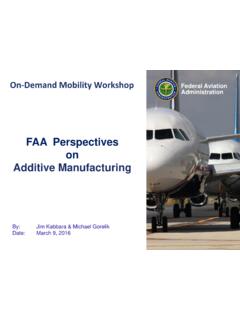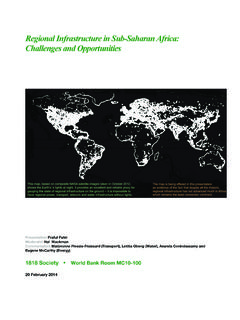Transcription of NASA Strategic Framework for On-Demand Air Mobility
1 NASA Strategic Framework for On-Demand Air Mobility A Report for NASA Headquarters Aeronautics Research Mission Directorate By AirMarkets Corporation Bruce J. Holmes, Roger A. Parker, PhD. National Institute of Aerospace Douglas Stanley, PhD. Mr. Peter McHugh Atlanta Analytics Laurie Garrow, PhD. STARNet, LLC. Mr. Paul M. Masson General Aero Company Mr. John (Jack) Olcott January 26, 2017. NASA Contract No: NNL13AA08B. National Institute of Aerospace Task Order: NNL16AA90T. Title: NASA Strategic Framework for On-Demand Mobility 1. NASA Strategic Framework for On-Demand Air Mobility This Page Intentionally Left Blank 2.
2 Table of Contents Executive Summary .. v Chapter 1 Introduction and Strategic 1. Prelude ..1. 1. Introduction ..1. NASA and Industry Perspectives .. 1. Universal Challenges .. 4. You Can't Get There from Here .. 5. Easy Access to Multiple Markets the Power of Social Networking Personified .. 6. Dude, Where's My Flying Car? .. 6. Aviation and Degrees C .. 7. External Strategic Context .. 7. Participants and Contributors .. 9. International Initiatives .. 9. 2. Summary .. 10. 3. Findings and Recommendations .. 11. Chapter 2 ODM Market demand .. 13. 1. Introduction and 13.
3 2. Literature Review .. 14. 3. The Quantitative Estimation of Air Travel demand .. 20. 4. The Definition of ODM and Thin-haul 24. 5. Estimates of demand for ODM Service .. 27. 6. Estimated of demand for Thin-haul Scheduled Service .. 33. 7. Potential for Using New Data Sources to Model Air Travel 37. 8. Forecast Results .. 38. Autonomous CTOL Air Taxi ODM .. 38. Autonomous Thin-Haul ODM 39. 9. Summary of Findings and Recommendations .. 39. 10. 40. Chapter 3 ODM Enabling Technologies and Gaps Analysis .. 45. Prelude .. 45. 1. Introduction .. 45. 2. Technology Assessment Process.
4 46. 3. NASA ODM Roadmap Development Summary and Analysis .. 46. 4. ODM Technology Roadmap Assessment .. 51. 5. Priorities, Gaps and Recommendations .. 51. Gaps .. 52. Proposed NASA ODM Technology Development Approach .. 53. Strategic Implementation of ODM .. 54. 6. Summary of Findings and Recommendations .. 55. Chapter 4 Organizational Contributions and Roles .. 57. Prelude .. 57. i NASA Strategic Framework for On-Demand Air Mobility 1. Introduction .. 57. Existing Stakeholders, Collaborators and Contributors .. 58. Industry Organizations .. 58. Trade Associations, Professional Societies, and NGOs.
5 59. Governmental Organizations ( ) .. 60. Governmental Organizations (International) .. 60. Academic and FFRDC Organizations (including Federally Funded Research and Development Centers) .. 60. 2. Potential International Collaborators .. 61. 3. Organizational Issues .. 61. 4. Options for Leveraging Organizational Cooperation .. 62. 5. Summary of Findings and Recommendations .. 63. Chapter 5 Public/Private Collaboration Options & Resource Alignment .. 65. Prelude .. 65. 1. Introduction and Background .. 66. Collaboration Options and the Role of Objectives and Requirements.
6 66. 2. Four Collaboration Options .. 67. 3. Criteria for Selecting an Option .. 68. Stakeholders .. 70. Executive-Level Commitment .. 72. 4. Technology Alignment .. 73. 5. Resource Alignment .. 74. 6. Assessing Partnership Options Against Criteria .. 76. 7. Findings and Recommendations .. 82. Chapter 6 National Policy and Regulatory Considerations for Enabling ODM .. 83. Prelude .. 83. 1. Introduction .. 83. 2. Growth Despite the Absence of Policy .. 84. 3. Tragedy Preempts Policy .. 87. 4. Additional 88. 5. Policy is Needed Now .. 88. 6. Vision Aligns Constituencies.
7 89. 7. ODM Involves Many Constituents .. 89. 8. Operator and Stakeholder Interviews and Regulatory Considerations .. 91. Response .. 91. 9. Regulatory Restraints vs. Regulatory Enablers .. 92. 10. Policy Must Reflect Vision and Facilitate Progress .. 93. 11. Establishing New Processes .. 93. Relevant Regulations Needed .. 93. 12. Seeking Consensus .. 95. 13. Essential Areas for ODM Development and Operation .. 95. 14. Summary .. 96. 15. Findings and Recommendations .. 97. Chapter 7 Stakeholder Outreach Planning .. 99. 1. Introduction .. 99. 2. Stakeholder and Participant Outreach Workshops 99.
8 Ii NASA Strategic Framework for On-Demand Air Mobility 3. Outreach Planning Schedule and Resource Requirements .. 100. 4. Venues .. 100. 5. Summary .. 101. 6. Findings and Recommendations .. 101. Appendix 1: Literature Review Annotated Bibliography .. 103. Appendix 2: The Models Used by the AirMarkets Simulation .. 104. The Trip Generation Model (TGM):.. 104. Trip Distribution Model (TDM): .. 105. The Discrete Choice Model of Travel 108. The Probability of demand in a Given Time Period .. 111. Appendix 3: The AirMarkets Simulator .. 114. Appendix 4: The Price Curve for Air Travel.
9 117. iii NASA Strategic Framework for On-Demand Air Mobility This Page Intentionally Left Blank iv NASA Strategic Framework for On-Demand Air Mobility Executive Summary The Aeronautics Research Mission Directorate (ARMD), NASA Headquarters, requested an analysis of the Strategic Framework and public value proposition for On-Demand Mobility (ODM). vision and concepts, to support decisions on research and technology development investments by the agency. This report responds to that request, and provides a high-level view from a team of subject matter experts experienced in all aspects of aviation innovation: aircraft, airspace, airports, operations, policy, regulation, technology, strategy, partnerships, and finance.
10 The Strategic Framework team reached the following distilled conclusions and related high-level recommendations: The vision for ODM of enabling the ability for anyone to fly from here to there, anytime, anywhere creates a compelling public value proposition that could result from a Federal R&D investment that would be vastly leveraged by the private sector. An ODM vision requires a national policy, informed by a technology strategy, to align the regulatory, partnership, and investment elements necessary to initiate new and accelerate current activities to keep pace with both national needs and advancing technologies.

